
by admin | Dec 4, 2013 | Cajun Country, Greater New Orleans, North Louisiana, River Road
With Thanksgiving behind us and the tree ready for decorating in our front room, I can officially say we’re full swing into the holiday spirit. This is the time of year I make my wish list of must-hit events and prepare the kids for running full steam ahead until Christmas.
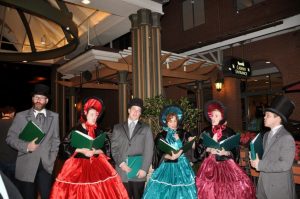 |
| Caroling at Miracle on Fulton Street |
We start with the tried and true ones, from Celebration in the Oaks at City Park to Santa, real reindeer and fake “snow” at the Miracle on Fulton Street. Then there’s the winter wonderland created in the lobby of the Roosevelt Hotel and the evening out sans children for a special Reveillon dinner.
We also try to mix in a few new experiences to brighten the holidays. Last year, we tried a children’s rendition of the Nutcracker at Loyola University and a staging of A Christmas Carol at the Contemporary Arts Center. For New Year’s, we ventured north to Natchitoches to experience the Christmas Festival of Lights, well worth the trip for anyone thinking of visiting this beautiful, historic town.
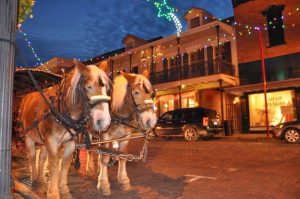 |
| Natchitoches’ Christmas Festival of Lights |
This year, I’ve been eyeing the Moscow Ballet’s Great Russian Nutcracker at the New Orleans Saenger. Perhaps we’ll set off out of town again to experience what the rest of the state has to offer. This weekend, the small town of Arnaudville pulls together some of the region’s best artists for Fire and Water: Le Feu et l’Eau Rural Arts Celebration.
It’s also the time for holiday bonfires, which, believe it or not, we have never seen! Oak Alley hosts their 38th Annual Christmas Bonfire Party this Saturday, Dec. 7. The 24th Annual Festival of the Bonfires lights up next weekend in Lutcher, offering a glimpse into the much-anticipated Christmas Eve bonfire spectacular in Gramercy and Lutcher.
With so much going on, it’s hard to decide where to even begin. Perhaps start with my article in Country Roads on ways for “Lighting the Dark” this holiday season or check out their Calendar of Events for endless possibilities. Maybe we’ll see you around town as you discover the joy of winter in Louisiana.
 |
| Mr. Bingle at Celebration in the Oaks |

by admin | Jun 30, 2013 | River Road
There is no shortage of scenic roads in this state, including many portions of Louisiana Highway 1. The longest road in the state, it runs from Grand Isle to north of Shreveport. We tackled a small portion of it last weekend, driving from Donaldsonville to Port Allen up the westbank of the Mississippi River before crossing over to end at Baton Rouge.
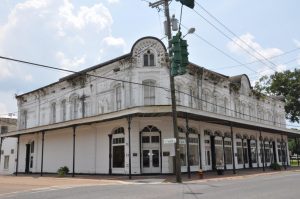 |
| Former Department Store, B. Lemann & Bro. building, in Donaldsonville |
Just a short distance from the Sunshine Bridge, Donaldsonville stands as the parish seat of Ascension Parish and a former capitol of the state of Louisiana (back in 1830). The town’s population and importance in history have fluctuated over the years, as evidenced by the vine-covered ruins of homes just off the main roads of Louisiana’s second largest historic district. Yet, the downtown streets are lined with impressive buildings that testify to this town’s importance and prosperity in the 1800s, long before the industrial plants entered the scene of this agricultural economy.
Many of the buildings are maintained today, such as the red brick courthouse and the one-time department store B. Lemann & Bro. building, both designed by architect James Freret. My particular favorites were the elk-adorned Italianate Elks Lodge and the “For Sale” Bel House, which looked like it was plucked right out of New Orleans’ French Quarter. Donaldsonville also lays claim to primitive artist Alvin Batiste.
 |
| Nottoway Plantation |
From here, we continued north toward Iberville Parish and the town of White Castle, famous for the south’s largest plantation resort – Nottoway Plantation. With 64 rooms and 53,000 square feet within the walls of this massive palace, Nottoway is best seen from River Road, where its white-columned front faces the Mississippi River. Built in 1859, this plantation was a modern marvel for its day, boasting running water in the bathrooms and gas lighting throughout the home’s interior. Today, the plantation has indeed become a resort, with a Grand Pavilion, a Mansion Restaurant, outdoor pool and cabana, and tennis courts. On the day we visited, tents were pitched throughout the property and RV’s lined the outer edges of the parking lot. We hadn’t passed a soul on River Road, yet Nottoway was swarming with people – certainly a hot attraction for the area.
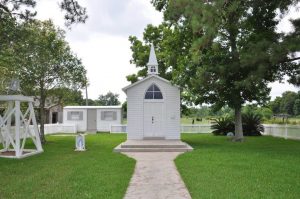 |
| Madonna Chapel |
In sharp contrast to Nottoway, the world’s smallest church resides just up the road in Bayou Goula. The tiny, one-room Madonna Chapel is sandwiched between a new house and a field of grazing cattle. We initially passed the site and, after turning around, pulled off the edge of River Road to make our own parking space. The kids bolted in the white picket fence in search of the hidden key to unlock the chapel. It wasn’t really “hidden,” only tucked away inside a box labeled “key,” but seeing as neither of them can read yet, they had quite the scavenger hunt.
The chapel was stifling hot inside, and we left the door open wide as we gazed at the small altar covered in statues of Jesus and Mary and read its touching story. Only eight feet square, the chapel was built in 1903 by a farmer, Anthony Gullo, who promised to build a church to the Madonna if she helped his oldest son recover from a serious illness. An annual mass is held here on August 15 in celebration of the Assumption of the Blessed Mother.
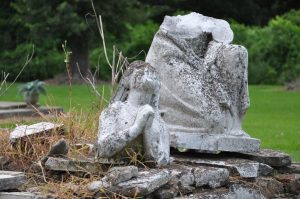 |
| St. Raphael Cemetery |
Our next stop was St. Raphael Cemetery, a crumbling grouping of graves and monuments laid out in the bend of the river across the Mississippi from St. Gabriel. Aside from the interesting architecture of the tombs, this is also the final resting spot for Louisiana’s 15th governor, Paul Octave Hebert.
River Road reconnected with Highway 1 in Plaquemine. A summer thunderstorm was rolling in as we pulled up to the Plaquemine Lock State Historic Site, and the skies opened up the moment we entered the lockhouse. The friendly, knowledgeable state park guide welcomed us to the museum and seemed to cater to our every need. Our two-year-old, August, was mesmerized by the working scale model of the lock system, anxiously watching the tiny lock doors open and the boat slowly make its way inside the lock. My husband grabbed a complimentary coffee and headed up the winding staircase for pristine views of the Mississippi River.
 |
| Plaquemine Lock State Historic Site |
As the rain stormed on, the ranger started a funny movie about singing fish to entertain the kids so we were free to browse the exhibits. We discovered the lock was built between 1895 and 1909 to connect the river with Bayou Plaquemine and was designed by Col. Goethals, who later became chief engineer of the Panama Canal. It operated for 52 years until shutting down when a larger lock was built in Port Allen.
When we ventured outside again to view the structure itself, my five-year-old, Charles, spotted an oversized beetle hiding in the doorjamb. Our host then pointed out an even larger beetle (scarily large) that thrilled Charles for the rest of the weekend. He made the bug a home in a coffee cup and carried him all over the property, from our walk up the levee to our stroll across the lock bridge and far below to the lovely waterfront boardwalk. After we (and the bugs) finished our journey, we drove the streets of Plaquemine, gazing at the historic homes and the St. John the Evangelist Catholic Church, “The Cathedral on the Bayou.”
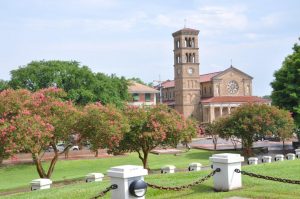 |
| St. John the Evangelist in Plaquemine |
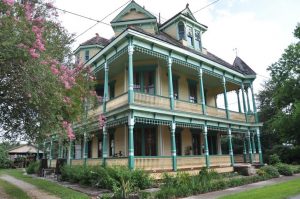 |
| Historic Home in Plaquemine |
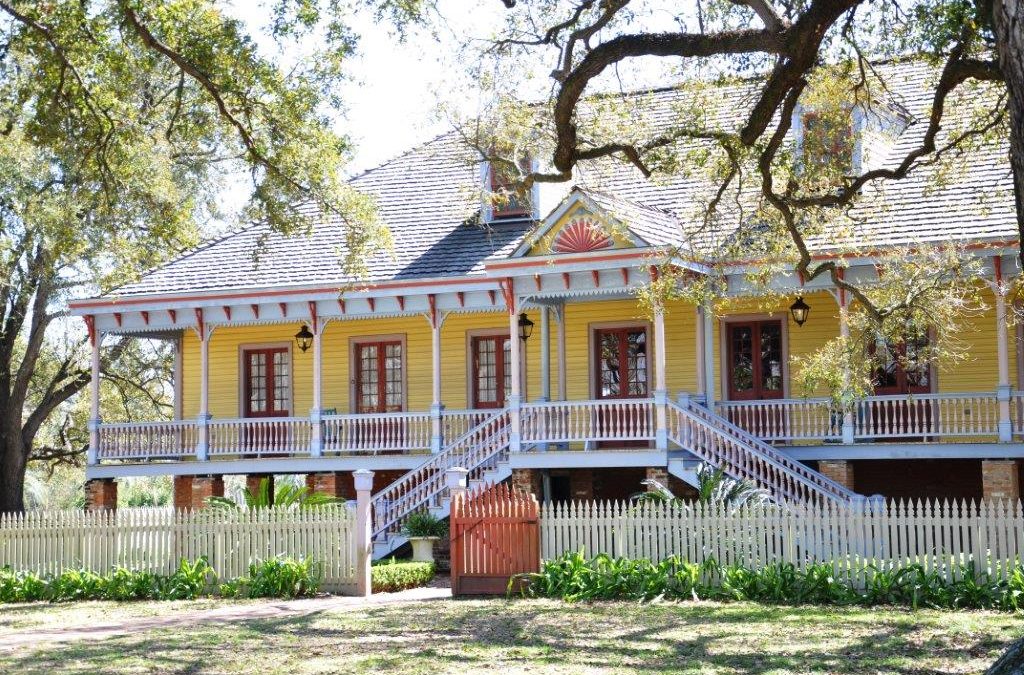
by admin | Mar 5, 2013 | River Road
It’s a rare event that we have an adults-only weekend, but acknowledging the antiques and information-filled tours at many River Road plantations, we reserved our trip there for just such a time. We started late on Saturday (after soccer, of course), dropped the kids at their grandparents and headed out I-10 toward Sorrento.
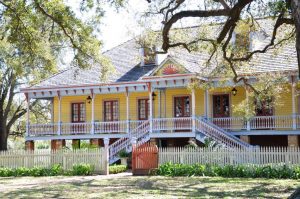 |
| Laura Plantation |
First up was dinner at The Cabin Restaurant, an original slave cabin from Monroe Plantation. Newspaper still plastered the inside, once used to insulate the former home. Filled with old farming equipment, our back dining room was built to look like a garçonnière, where bachelors stayed on a plantation. The food was hearty and low-key, with the chicken and sausage gumbo coming as a top recommendation from our waitress. There appeared to be a collection of old buildings in the courtyard–slave cabins, a general store and the first Catholic school established for children of color, but unfortunately it was too dark to look around.
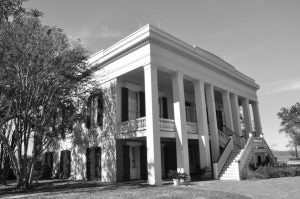 |
| Bocage Plantation |
Our destination for the evening was Bocage Plantation, a masterfully restored plantation home built in 1837 on land once owned by a descendant of Christopher Columbus. Now open as a bed and breakfast, the four-bedroom mansion offers guests the ultimate in luxury. Our host greeted us with a tour of our room, the first-floor Venetian Room decorated with rich colors, an inlaid ivory bed and antiques we’ve only seen in the finest of homes. With a glass of wine in hand, we spent the evening in good conversation with our fellow guests–a doctor from Houston, an engineer from Baton Rouge and our gracious manager and tour guide Roberto.
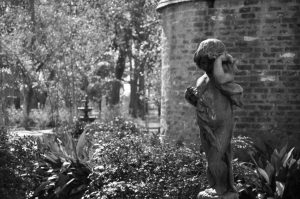 |
| In the garden outside Bocage Plantation |
We awoke to the smell of bacon (yum!) and marveled at the walk-in steam shower that fought for our attention against the elaborate breakfast waiting for us in the dining room. Our master chef Igor, a native from Ukraine, whipped up omelets, biscuits and apple pancakes all served on fine china alongside our fruit-filled crystal bowls and espresso. Although he spoke little English, he told us of his love of black and white photos, so the pictures featured in this blog are converted in his honor.
The morning was chilly outside, but we bundled up and walked the grounds for better views of the mansion. Horses grazed in the fields next to us and ruins lay in the back of the property from when sugar cane used to be harvested and burned on the property. We said our goodbyes and pointed the car toward the Sunshine Bridge, crossing the Mississippi River and carrying on to the other side.
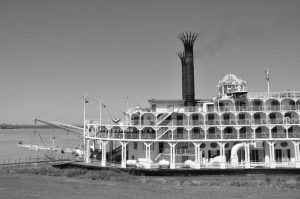 |
| American Queen Steamboat |
Traveling south, we were struck by the sight of a steamboat docked along the river’s bank. We quickly pulled over and climbed the levee to get a better view of the American Queen, stopped in Vacherie on its voyage from New Orleans to Memphis. Turning around, we smiled at the familiar row of 300-year-old live oaks lining the path to Oak Alley Plantation, probably one of the most photographed places in the country. We only had a minute to take in the view, though, before we continued on to make our tour at Laura Plantation.
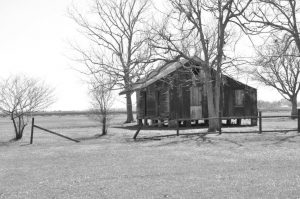 |
| Slave cabin at Laura Plantation |
The elevated and brightly colored Laura Plantation home stands as a tribute to the generations of Creoles and their slaves who once lived on this property. In one of the most captivating Louisiana accents I’ve ever heard, Stephen, our tour guide, led us through the history of Laura Locoul’s family. The tour is based on Laura’s memoirs and spares no details in describing the lives of her ancestors, from their business successes to their personal sacrifices, from the raw, but generally accepted treatment of slaves to the family’s own downfalls. It’s a thought-provoking tour–one that will stay with me for quite some time.
Unfortunately, there is only so much time in a weekend, and the rest of River Road’s grand plantations had to be saved for another day and another adventure.
 |
| Oak Alley Plantation |
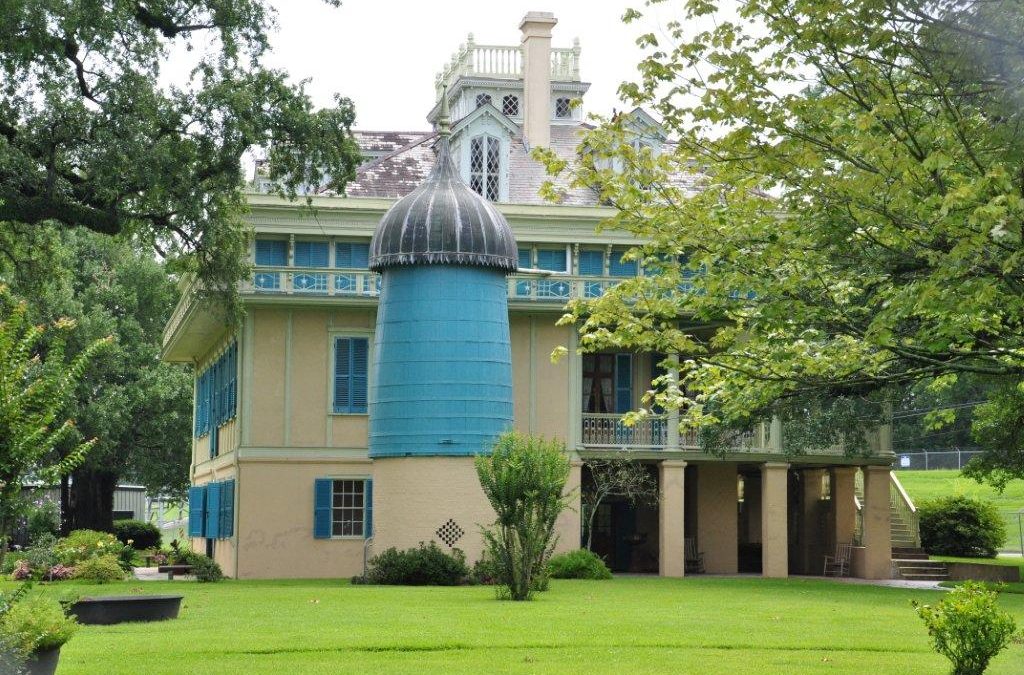
by admin | Jun 19, 2012 | Cajun Country, River Road
We recently took to the road and set off on a decent hour (give or take) drive to Thibodaux. I came prepared with snacks, drinks and a movie for the allotted time, and the trip would have been perfect except for one small flaw. The Hale Boggs Bridge crossing the Mississippi River was closed. How we missed this crucial piece of information was beyond me, but here we were, stuck with a last minute decision to go downriver to the Huey P. Long Bridge or upriver toward the Veterans Memorial Bridge.
Much to our children’s chagrin, we chose the scenic River Road route upriver to Gramercy. It brought back memories of the road trips we took when we younger, fresh out of college, sans children and with lots of time to wander freely. Unfortunately, children scoff at nostalgia. But we made the most of it and discovered parts of the state we’d never seen before, and as with all memories, I’m sure to only remember the good parts of the trip!
The detour began with a sudden stop at the stunning St. Charles Borromeo Catholic Church. Although not open, the expansive grounds and beautiful church and school begged to be photographed–if only it wasn’t raining. For years, the “Little Red Church” was a welcome sight to steamboat captains traveling the Mississippi River to New Orleans, alerting them to the end of their journey.
 |
| Bonnet Carre Spillway |
Only a bit farther up the road, we encountered the first of several plantations we would see on this trip. Ormond Plantation, built around 1790, is brilliantly restored and open for tours detailing its storied past.
River Road takes a sharp right turn at the Bonnet Carre Spillway, a location made famous by the floodgates opened here whenever the Mississippi River comes dangerously close to topping its levees. I’d seen it on TV and in pictures hundreds of times, but never in person. The photos don’t do justice to the vast complex, and it was a startling sight to see just traveling along the road.
As River Road enters the Spillway, you descend into miles of open fields, giving the impression you’ve been transported to the country roads of Kansas. One man, who was throwing a stick to his dog, looked so out of place I had to check in the rearview mirror to make sure he was really there. It’s gone before you can shake the eerie feeling, and the road continues on as if nothing had changed.
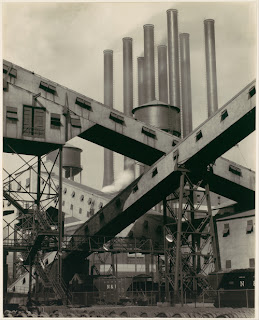 |
| Scheeler’s photo of Ford’s auto factory |
Although only separated by a levee from the Mississippi River, you would never know the swiftly flowing water was right next to you. It’s largely hidden from view, yet strangely connected to the land via large tubes crossing over the road. These link to the countless refineries and factories lining much of River Road, creating a foreign, but oddly interesting, landscape.
I remember traveling River Road at night and seeing the factories ablaze with lights–tiny towns functioning independently from others around them. There was an artist by the name of Charles Sheeler hired to photograph and paint similar factories and show off their inner beauty. Through his eyes, the maze of pipes became exquisite pieces of architecture. If you squint really hard and bury the innate feeling of driving “Cancer Alley,” you begin to see his perspective.
This is what I was contemplating when we came upon San Francisco Plantation, a lavishly ornate and boldly colorful mansion that inspired Francis Parkinson Keyes to write “Steamboat Gothic.” The house and grounds were amazingly pristine, yet out of place sandwiched beside another factory.
 |
| Godchaux-Reserve House |
We saw other plantations and extremely old homes sitting neglected and slowly melting back into the dirt and trees on the side of the road. There’s no telling how many of these structures have been lost to time, and by the looks of it, many of the ones we recently saw won’t be around for much longer. Some though, like the Godchaux-Reserve House–marked by the locomotive standing on its property–has been taken on by the community in an effort to preserve its structure and importance in history.
So finally arriving in Gramercy, we’re treated to expansive views of the river as we crossed high above its waters. The remainder of our drive south to Thibodaux was fairly uneventful, spent munching on popcorn from the local convenience station while we drove through open fields and torrential rain. As we entered Thibodaux, the flooding stopped as if a faucet had been turned off.
 |
| Wetlands Acadian Cultural Center in Thibodaux |
We drove the town, getting the lay of the land and counting the churches along Canal Boulevard. A sign for the Jean Lafitte National Historical Park directed us along Bayou Lafourche to the Wetlands Acadian Cultural Center. The kids sprinted through the exhibit area, showcasing the lives of the Cajuns, but then became engrossed in playing with the dozens of puppets and kid-sized palmetto hut in the kids’ “Gumbo Room.” Outside, a boardwalk overlooked scenic Bayou Lafourche.
Historic downtown Thibodaux is dominated by the Dansereau House Bed and Breakfast, the crown jewel of the city. The one-way streets through the city are lined with boutiques and restaurants, creating a vibrant yet intimate downtown.
We backtracked slightly out of town to eat at Boudreaux’s Restaurant, which came highly recommended by the Jean Lafitte park rangers. It was a good suggestion as we found plenty of tasty food to dine on, and the wait staff were very tolerable of two, umm, “active” children.
The route home took us along picturesque Highway 1, which parallels Bayou Lafourche, past Nicholls State College to Highway 90. We chose the quicker return route as the rain clouds rose high above us, threatening to let loose at any minute.
 |
| View of Bayou Lafourche |





















